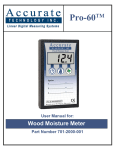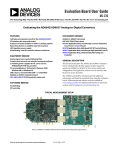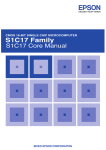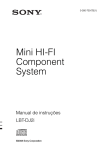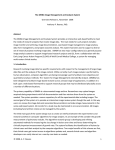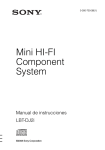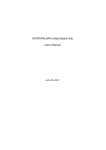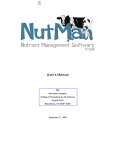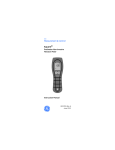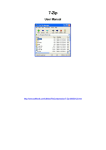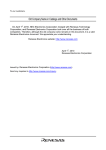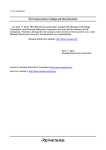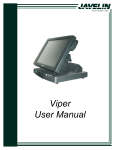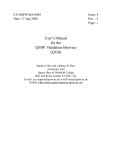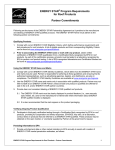Download Moisture Meter Instruction Manual
Transcript
Moisture Meter Instruction Manual IN- Wagner Models L606/L607 1-800-944-7078 Table of Contents Introduction .................................................. Pages 2-3 Instructions ................................................... Pages 4-5 Features ....................................................... Pages 6-7 Taking Measurements ................................... Page 8 Species Corrections ....................................... Page 9 Measuring Veneer ......................................... Page 10 Meter Calibration .......................................... Page 11 Meter Storage ............................................... Page 11 Questions & Answers .................................... Pages 11-18 Commentary on Species Adj. Table ................ Pages 19-20 Determining Specific Gravity (SG) ................ Pages 21-22 Zero Adjusting .............................................. Page 23 Warranty ...................................................... Pages 24-25 Repair Service .............................................. Page 26 FCC Compliance Statement .......................... Pages 27-28 Introduction Congratulations! You have purchased one of the most accurate moisture measurement instruments for wood in the world. Using patented electromagnetic wave technology, Wagner handheld meters have been proven by universities and institutes worldwide to provide superior measurement results. Utilizing an electro-magnetic field, your Wagner moisture meter measures a relatively large cross-sectional area each time you take a reading, giving you a far better representation than other technologies of the true moisture content of your wood. Pin-type meters do not 2 Introduction cont’d. provide this, only measuring a very small area, and only at a particular depth. Very short, non-insulated pins are especially prone to just reading the surface of your wood. Your Wagner L606 meter measures the moisture content in a 11/2 inch wide by 21/2 inch long by 3/4 inch (minimum) thick volume of your wood. The Wagner L607 meter measures a 1/2 inch (minimum) thick volume of wood. This closely approximates the full-thickness cross-section method used when performing the ASTM D 4442-92 Oven Dry lab test for determining moisture content in wood. This ASTM standard (and its international counterparts) is the standard to which all moisture meters for wood are compared for accuracy. Wagner technology has been proven in many studies to provide some of the most accurate results in the industry when compared to this worldwide standard. Other important features of Wagner hand-held meters include: • The "Wood-Friendly"™ L606 and L607 meters use advanced electromagnetic wave technology to accurately measure wood moisture content.* • Virtually unaffected by wood temperature or surface moisture.** * Confirmed in university study– “Information available upon request.” ** Contact Wagner technical support for guidelines when wood is frozen. 3 Instructions TO OPERATE: press and release the ON button. Take readings by pressing the bottom of the meter to the wood surface. The meter will automatically shut off after 60 seconds of inactivity. 1. Read the % MC on the panel meter (Figure1). If the wood is Douglas Fir, the scale reading indicates the % MC in the wood. 2. If the wood is not Douglas Fir, you must make a species correction. SPECIES ADJUSTMENT TABLES are provided. When measuring a species other than Douglas Fir, use the tables to locate your species and corresponding meter reading. Example: Figure 1 Your meter reading is 13% (Figure1). Your species is Basswood, American. Locate your species on the tables provided. Find the species in the appropriate row. Find the meter reading in the appropriate column. Where row and column intersect is the actual reading for Basswood, American—16.5%. 4 Instructions cont’d. THE LOW-BATTERY light will come on when the battery needs replacing. Replace with either a 9V alkaline battery. Observe correct polarity. CALIBRATION is factory set. Factory calibration can be verified using a calibration verification block (CVB). The CVB is for calibration verification only. NEVER calibrate your moisture meter to this device. Additional Instructions for Model L607 “ONLY” WATERBORNE FINISHES can be quickly scanned between applications. 1. Simply check the base moisture content of the wood before applying a waterborne finish. 2. After application of finish, scan representative area of the wood and note the elevated moisture content. 3. Re-scan at regular intervals until the moisture reading once more drops to the base level first recorded before applying finish. 4. When the reading matches the base-level reading, the wood is ready for recoating. * Confirmed in university study– “Information available upon request.” 5 Features The Wagner L606 “Inspector” Moisture Meter Designed to fit comfortably in a jacket pocket or toolbox, the L606 is ideal for anyone who needs a professional quality tool to inspect wood or wood products for accurate moisture content. It is popular with installers, wood workers, cabinet and furniture makers, contractors, and quality assurance inspectors. • Deep penetrating, pin-free inspecting ends wood abuse. • Quick whole-board scanning. • Proven technology used by agencies to grade a large percentage of U.S. wood.* • Accurate and consistent–confirmed in university study.* The “Wood-Friendly” L606 uses advanced electromagnetic wave technology to accurately measure wood moisture content from 5% to 30% to a depth of 3/4". There are no pins to “abuse” wood and leave ugly holes. * Confirmed in university study– “Information available upon request.” 6 The Wagner L607 “Dual Depth” Moisture Meter Represents the latest in electromagnetic field (EMF) technology. This meter is ideal for the professional concerned about accurate moisture measurement of finished wood products . . . and for managing the application of waterborne finishes. • Fast operating–quickly scan large portions of wood for a more accurate picture of moisture content. • When using waterborne finishes, know exactly when to recoat and avoid costly waiting and guessing when sealer and finish are dry. The L607 is especially calibrated to read waterborne finish applications and yet work as a regular wood moisture meter when doing inspections. • Handy to use–fits comfortably in your hand, and stores easily in a jacket pocket or toolbox. • Useful for inspections of all types, including solid and laminated products–1/2" scan depth. • Accurately measure wood moisture content* from 5% to 30% using advanced electromagnetic wave technology. • NO PINS to “abuse” wood and leave ugly holes. 7 Taking Measurements Be sure to press down firmly on the center of the meter with approximately 3 pounds of pressure to ensure good sensor plate contact with the wood surface. This is especially important on rough-sawn lumber.* Do not take readings where there is a noticeable defect or knot in the lumber. If there is visible surface moisture or water, wipe off any excess, and let the surface of the wood dry-out for a couple of minutes, then take the reading. If possible, turn the board over and measure the other side. If the thickness of the piece is greater than 1 1/2 inches (1 inch with L607), it is a good idea to take measurements on both sides. Ensure that there is nothing (especially your hand or metal) under the material you are measuring. The actual moisture sensing area is a 11/2 inch by 21/2 inch rectangle on the meter’s backside (opposite side of the panel meter). In order to take a valid measurement, this sensing area must be completely covered with the wood you are measuring. If the sensing area is not completely covered, your moisture reading will be inaccurate. Additional meter corrections may be necessary if you are measuring Raft Wood (salt water permeated), or lumber treated with Copper, Chrome, Arsenic (CCA), or Ammonical, Copper, Quantenary (ACQ).** * The Wagner model L607 is not designed for use on rough-sawn lumber. ** Contact Wagner Technical Services for further information for these applications. 8 Species Corrections The dry specific gravity (density) values for a species are based on the best, current world data, and are used to determine the species correction factor within the meter. The values provide average density values for the species. A coefficient of variation (COV) of about 10% describes the variability inherent in many common domestic (US) species. If the specific gravity of your lumber cannot be found with the resources listed in the tables provided or you are dealing with an unknown species, the value may be determined by referring to the “Determining Specific Gravity” section of this manual. Additional resources are: the Forest Products Lab at http://www.fpl.fs.fed.us/ and the Wood Handbook at: http://www.fpl.fs.fed.us/documnts/fplgtr/fplgtr113/fplgtr113.htm The Wagner hand-meters can be used to measure non-wood materials if the density is similar to wood products. Nonwood species can be measured by using the meter reading as a relative value such as in “go/no-go” applications, or when determining if one measurement area contains more moisture than another, i.e. measurements that do not require a high absolute accuracy. SG formulas can’t be applied to non-solid wood species due to the presence of glues and resins, which cause a non-linear moisture content curve. If greater accuracy is required, the ASTM oven-dry procedure can be used to determine a meter correction value for nonsolid woods. Please contact Wagner Electronics at: (541) 582-0541 for additional information on species corrections if needed. 9 Measuring Veneer Checking the moisture content in veneer You can check the moisture content of veneer with your Wagner hand-held moisture meter as follows: 1. Put veneer into a tight stack and separate the stack by at least 3 inches to 4 inches from the rest of the stack. Vary the thickness of the stack according to unit penetration depth, example: L606 has a 3/4” depth of penetration. Measuring a stack less than the scan depth of the meter will give you a reading that is lower than the true moisture reading. Refer to the species adjustment section in your manual for the wood you are using. 2. Electro Static Discharge (ESD) needs to be prevented, as Wagner’s warranty doesn’t cover ESD damage. The instruments are tested to withstand a 15 KV static charge but not the typical 150 - 250 KV found in a veneer charge. The veneer table should be earth grounded with a metal wand attached by wire to the table. The wand must then be run up and down the edge of a veneer stack to discharge static, or the person using the moisture meter must have a Velcro wrist band with a tethered strap which is grounded. These same static precautions apply to lumber moving from a planer; the hand-meter is not an in-line measurement system. This unit is meant to check lumber while stationary. If these guidelines are adhered to, the risk of ESD damage to your moisture meter is greatly reduced or eliminated. Please call the factory if you have any questions or concerns about this information. 10 Meter Calibration The meter has been calibrated at the factory and should not require re-calibration. If you need to have the calibration verified, please contact the Wagner Electronics Sales Department to purchase a calibration verification block if you don’t already have one. Should the meter need to have a calibration adjustment, it will need to be returned to Wagner Technical Services Department. Meter Storage For a long service life, it is important to store your meter properly. Avoid excessively hot or cold locations, and keep the meter in the case provided. Do not store the meter in an area with excessive electro-magnetic interference, such as near an electric motor, or where it could be crushed, such as in front of a forklift. Do not leave the meter in an operating kiln during the drying cycle. Questions & Answers #1 Wagner Technology Q: I’m nervous about buying a new technology. How long has Wagner Electronic Products been designing and manufacturing this type of moisture meter? A: Since 1966, Wagner Electronic Products has been providing quality moisture measurement equipment. Wagner is the leading supplier of moisture measurement equipment for the primary forest products industry. Closely scrutinized and approved by numerous university studies and used for years by professional wood-grading 11 Questions & Answers cont’d. associations, Wagner’s meters continue to prove reliable and consistent, with unsurpassed convenience and easeof-use. #2 Theory of Operation Q: How do Wagner Hand-Held Moisture Meters operate? A: Wagner Hand-Held Moisture Meters send technologically advanced electromagnetic radio waves deep into the wood without leaving destructive holes. Known around the world for speed and accuracy, Wagner meters supply instant readings, scanning large amounts of board feet in seconds. Virtually unaffected by temperature* and humidity, they scan right through finished products. * For frozen wood with up to 15% moisture content, accurate measurements can be obtained. When the frozen lumber moisture content is suspected to be over 15%, contact Wagner technical support. #3 Gradients and Wet Pockets Q: What about gradients and wet pockets? A: Although the various drying processes for green lumber can leave wet cores and pockets, moisture continues to pass from fiber to fiber within the wood until it has equalized throughout the whole board. Determining if a board or load of lumber will equalize within tolerance levels can be difficult and tricky, but Wagner Moisture Meters provide this information automatically. Penetrating deep into the wood, they mathematically 12 determine equalized moisture content and allow the user to check truckloads of material in minutes. For even more convenience, many companies use their Wagner HandHeld Meters to read through the plastic wrapping around the wood on new deliveries before they allow unloading. #4 Where are Readings Taken Q: Where is the reading taken with a pin-type meter? With a Wagner Hand-Held? A: Pin-type Meters take their measurements between the tips of the pins only, if using insulated pins. When using non-insulated pins you are getting a reading between the pins at only one point between them at which you have most the moisture. In contrast, Wagner Hand-Held Moisture Meters generate a three-dimensional field and give an average reading of the material within the sensing area and depth of penetration for the model of meter you are using. #5 Surface Moisture Q: Is my Wagner Moisture Meter affected by surface moisture? A: Most moisture meters can be affected by standing water or visible water on the board. You should always wipe off as much excess water as possible. Once the standing water is removed, your Wagner Moisture Meter will read slightly higher than normal, whereas other types of meters can show greatly exaggerated readings. An exception to this is the Wagner Model L607. This unit was designed to measure surface moisture to test the cure of waterborne finishes. 13 Questions & Answers cont’d. NOTE: If water is allowed to soak into the wood, it will naturally show higher moisture content. If a piece of wood is quite rough, it will soak up the water quite readily, affecting readings for all meters. #6 Narrow Lumber Q: What is the narrowest piece of lumber I can measure accurately with the Wagner Hand-Held Moisture Meter? A: This would depend on the model you are using. The narrowest piece you could measure would be a minimum of 7/8 inch. #7 Board Thickness Q: What board thickness can I measure? A: This would depend on the model you are using. Wagner offers models with 1/2 inch, 3/4 inch and 1 inch penetration. #8 Meter Orientation Q: What about the orientation of the meter on the wood? A: Your Wagner moisture meter uses advanced electromagnetic wave technology and is virtually unaffected by orientation (cross-grain or with the grain) on the wood except for the model L609 which requires measuring parallel to the grain. 14 #9 Meter Ruggedness Q: How rugged is my Wagner moisture meter? A: The Wagner moisture meters are designed for compact convenience. They can be damaged by being dropped or slammed down hard on wood surfaces, as can any meter. If a large volume of wood is to be measured, an in-line system should be used. #10 Meter Safety Q: Is the Wagner technology safe to use? A: Wagner’s electromagnetic wave technology produces less electromagnetic radiation than standard house wiring. #11 Wagner Vs. Pin-Type Meters Q: How can I take accurate moisture readings without sticking pins into my wood? Why doesn’t my new Wagner Hand-Held Meter read the same moisture content as my old pin meter? A: Pin-type meters work on a resistance principle that basically measures the flow of electricity through a substance. This method is subject to many environmental variables that can dramatically affect moisture readings such as chemicals in the water trapped within the wood and the temperature of the wood. Pin-type meter readings often need to be corrected for any difference in temperature above or below 70 degrees F. Wagner HandHeld Moisture Meters use advanced electro-magnetic wave technology and are virtually unaffected by surface moisture* or temperature. 15 Questions & Answers cont’d. * The Wagner model L607 has been designed to be sensitive to surface moisture which takes the guesswork out of when to recoat with waterborne finishes. #12 Relative Humidity Q: What are the effects of relative humidity on Wagner Hand-Held Moisture Meter readings? A: As long as there is no condensation on the bottom surface of the instrument there is virtually no effect from changes in relative humidity. #13 Calibration Q: Do the meters on the Wagner Hand-Held products ever require readjustment? Does my Wagner Hand-Held Moisture Meter need to be calibrated? If so, how often must it be done? A: Wagner Meters are calibrated at the factory. With proper care the meters stay in calibration. In the event that the meter has been dropped or you suspect for any reason that the meter is out of calibration, a calibration verification block is available. Anytime that the meter is not reading correctly on the calibration block, it should be sent to the factory for calibration. #14 Veneers Q: Can I use my Wagner moisture meter to measure veneers? 16 A: Measuring moisture in veneer requires specific procedures. Wagner has established guidelines for measuring these materials. See the “Measuring Veneer” section of this manual for guidelines on this procedure. #15 Rough Vs. Smooth Lumber Q: Can I use my Wagner meter to measure rough-sawn lumber? A: When measuring rough-sawn lumber press down firmly on the center of the meter with approximately 3 pounds of pressure to ensure good sensor plate contact with the wood surface. Do not take readings where there is a noticeable defect or knot in the lumber. #16 Sub-Floor Material Q: Can I use my Wagner meter to measure sub-floor materials such as plywood or OSB? A: Wagner has established guidelines for measuring these materials. See the “Plywood and OSB Correction Factors” section of the Species Adjustment Table manual for guidelines on this procedure. #17 Temperature Q: Are the readings that I take with my Wagner meter affected by the temperature of the wood like those taken with a pin-type meter? A: Wagner's proven moisture meter technology is virtually unaffected by wood temperature. Pin-type meters and other unproven pin-free technologies, can be 17 Questions & Answers cont’d. greatly affected by wood temperature, which often require corrections. #18 Accuracy Q: How accurate are the Wagner Hand-Held Meters? A: The Wagner Moisture Meter is as accurate, or more accurate than any moisture detector that is on the market. This can be verified by several university studies. #19 Correct Moisture Content Q: What is proper moisture content for wood? What moisture content is considered too high or too low? A: There is no one right answer for this question. As a rule, different woods and their uses determine the moisture content. For instance, if the wood is to be used in construction as a stud for building, the moisture-content requirement could be 15% to 19%. If the wood is to be glued and it is too dry, it will not bond; if it is too wet, it will not hold. Ideally, the moisture content of wood to be used for indoor furniture is between 6% and 8%. Note: Detailed information on this subject is available in the video section of the Moisture Measuring & Management Reference Library CD supplied with your moisture meter. In addition, you can contact your local university’s forestry department, the associations supporting your industry’s professionals, or the Forest Products Research Laboratory in Madison, WI: 608-231-9200. 18 Commentary on Species Adjustment Tables In 1992, a study was conducted at the Forest Research Laboratory of Oregon State University on species correction for the Wagner Hand-Held Moisture Meters. The species tested were Douglas Fir, Lodgepole Pine, Western Red Cedar, Western Hemlock, White Fir, Western Larch, Engelmann Spruce, and White Oak. Three to four 40-piece samples of each species were tested. Specific gravity was found to be the primary factor on species adjustment. A species equation as a function of specific gravity and the meter reading was obtained using multiple-regression technique (R-square = 0.95) as follows: AF = 8.77 + (0.25 * MM) - (15.86 * SG) - (0.62 * SG * MM) in which: AF = Adjustment Factor MM = Meter Reading SG = Species average Specific Gravity in oven dry weight and 12% moisture-content volume basis. The species adjustments provide the adjusted moisture measurements that are based on the species adjustment determined using the species adjustment equation, with rounding to the nearest 0.5. Wood is not a uniform material. Specific gravity of solidsawn lumber varies within the piece and among pieces. In the OSU study, the average specific gravity for each species differed from the individual sample by plus or minus 1% to plus or minus 8%. For general applications, average specific gravity values can be found in the Wood Handbook (USDA Agriculture Handbook No. 72, 1999). Except for one species 19 Commentary on Species Adjustment Tables cont’d. for which the experimental value is 7% higher, the species’ overall average specific gravity values obtained in the OSU study are comparable with those in the Wood Handbook. The exception may be caused by unknown biases in the sampling scheme. The Wood Handbook values are used in the tables, except for the imported species, unless otherwise noted.. Species adjustment can be determined for lumber sorted, or otherwise known, to have specific gravity different from the species’ average. One example is lumber graded under the Dense rules. If the specific gravity of a lumber sample is known, species adjustment can be determined by the species adjustment equation. The species adjustment equation provides a way to expand the use of your Wagner Hand-Held Moisture Meter for lumber of any species groups having similar species-specific gravity values. One example is Hem-Fir. For a species group, one way to determine the species adjustment is by the use of a weighted average of the individual species’ average specific gravity values. The weighing procedure used in the ASTM D2555 by standing timber volume can be used. Species adjustment is not recommended for any species group having a broad range of species-specific gravity values. There are no recognized limits on species group species adjustment. Species adjustment for species groups should be used with knowledge on the variability on species involved and the affect of it on species adjustment. If the species mix in the lumber production of a species group is controlled or known to have specific gravity different from that used for the species group, a better estimation of species adjustment can be determined using the known specific gravity in the above species correction equation. 20 Determining Specific Gravity Determining the Adjustment Factor for an Unknown Species The adjustment table based on specific gravity of solid wood is provided on the following page. If you don’t know the species of the wood you are using, or the specific gravity differs from the handbook because of a different growing region, use the following procedure. Determining the Specific Gravity 1. Select a sample of wood with all edges being true. Carefully measure the dimensions of the sample using a caliper. You will need the length, width, and thickness. 2. Convert these measurements to feet. 3. Carefully measure the weight of the sample. 4. Convert the weight to pounds. 5. Calculate specific gravity. 21 Determining Specific Gravity cont’d. Example: Length = 10 in. 10 in. / 12 in. = 0.833 ft. Width = 7.5 in. 7.5 in. / 12 in. = 0.625 ft. Thickness = 1.5 in. 1.5 in. / 12 in. = 0.125 ft. Volume = L x W x T 0.833 x 0.625 x 0.125 = 0.065 cu. ft. Weight = 20 oz. 20 oz. / 16 oz. = 1.25 lb. Specific Gravity: (Weight / Volume) / Specific Gravity of water (1.25 lb. / 0.065 cu. ft.) / 62.34 lb. / cu. ft. = 0.31 In order to ensure that the value obtained for the specific gravity is statistically significant, a number of pieces must be measured and the average determined. Use this value of specific gravity with the table provided to find the actual adjustment factor for your species of wood. 22 Zero Adjusting WARNING! WARNING! WARNING! WARNING! WARNING! Do Not Use This Section of the Manual Unless Absolutely Necessary! BECAUSE of the stability of the circuit in these products, a person virtually never has to adjust the zero setting. ZERO-ADJUSTING a meter is a two-step process. (1) With the power OFF, adjust the PHYSICAL ZERO (Figure 1) until the needle rests precisely on the lowest mark on the scale (Figure 2). (2) Remove the DRY BOX ZERO cap (Figure 1). Hold the meter in midair so that the bottom is level and several feet from any object. Press and release the ON button; this will cause the needle to rest near the lower edge of the DRY BOX. Insert a small screwdriver into the hole and adjust the DRY BOX ZERO until the needle rests precisely on the lower edge of the DRY BOX (Figure 3). Figure 1 Physical Zero Figure 2 Physical Zero—Adjust until needle sits on lowest mark. Dry Box Zero Figure 3 Dry Box Zero—Adjust 23 until needle sits on lower edge of Dry Box. Wagner Electronic Products, Inc. Limited Warranty Wagner Electronic Products, Inc. warrants this product against defects in material and workmanship for one (1) year from the date of purchase, subject to the following terms and conditions: Wagner’s liability under this warranty shall be limited, at Wagner’s option, to the repair or replacement of this product or any part thereof, which is demonstrated to be defective. To exercise this warranty, customer must telephone, fax or e-mail Wagner's Customer Service Department for a RMA (Return Materials Authorization) number and factory instructions for shipment. This limited warranty does not apply if the product has been damaged by accident, negligent handling, misuse, alteration, damage during shipment, or improper service. Wagner Electronic Products, Inc., shall in no event be liable for any breach of warranty or defect in this product, which exceeds the amount of purchase price of the product. Wagner Electronic Products, Inc., shall not be liable for incidental or consequential damages for the breach of any express or implied warranty with respect to this product or its calibration. With proper care and maintenance, the meter should stay in calibration; however, because Wagner Electronic Products, Inc., has no control over the manner in which the unit will be used, it makes no warranty that the meter will stay in calibration for any specific period of time. Wagner Electronic Products, Inc., recommends returning the unit to the factory for a diagnostic checkup and recalibration in the event the meter is dropped or otherwise damaged, or the meter accuracy is suspect. 24 This warranty is in lieu of all other warranties, whether oral or written, express or implied. Any implied warranties, including implied warranties of merchantability and fitness for a particular purpose, are excluded. If this product is not in good working order as warranted above, the customer’s sole remedy shall be repair or replacement as provided above. Wagner Electronic Products, Inc. shall not be liable for incidental or consequential damages for the breach of any express or implied warranty with respect to this product. This warranty is personal to the customer purchasing the product from Wagner Electronic Products, Inc. and is not transferable. This warranty also gives you specific legal rights, and you may also have other rights, which may vary, from state to state. The agents and employees of Wagner Electronic Products, Inc. are not authorized to make modifications of this warranty or additional warranties binding on Wagner Electronic Products, Inc. Accordingly, additional statements, whether oral or written, except written statements from an officer of Wagner Electronic Products, Inc. do not constitute warranties and should not be relied upon by the customer. Wagner Electronic Products, Inc. shall in no event be liable for any breach of warranty or defect in this product, which exceeds the amount of the purchase price of the product. 25 Repair Service In the event of damage or failure, contact the Wagner Electronics Technical Services Department to arrange for repair and to acquire RMA Number with the appropriate repair form. Your meter will be repaired, calibrated and returned promptly. When you send your meter, be sure it is insured. We cannot be responsible for items that do not reach us. The Technical Services Department is available during normal business hours—7:30 a.m. to 4:00 p.m. Pacific Standard Time, Monday through Friday. Voice: (541) 582-0541 Fax: (541) 582-4138 E-Mail: [email protected] Mail: Technical Services Department Wagner Electronic Products, Inc. 326 Pine Grove Road Rogue River, Oregon 97537 USA 26 FCC Compliance Statement This equipment has been tested and found to comply within the limits for a Class B digital device, pursuant to Part 15 of the FCC Rules. These limits are designed to provide reasonable protection against harmful interference in residential installations. This equipment generates, uses, and can radiate radio frequency energy and, if not installed and used in accordance with the instructions, may cause harmful interference to radio communications. However, there is no guarantee that interference will not occur in a particular installation. If this equipment does cause interference to radio or television equipment reception, which can be determined by turning the equipment off and on, the user is encouraged to try to correct the interference by one or more of the following measures: • Reorient or relocate the receiving antenna. • Move the equipment away from the receiver. • Plug the equipment into an outlet on a circuit different from that to which the receiver is powered. • If necessary, the user should consult the dealer or an experienced radio/television technician for additional suggestions. CAUTION: Only equipment certified to comply with Class B (computer input/output devices, terminals, printers, etc.) should be attached to this equipment. Finally, any changes or modifications to the equipment by the user not expressly approved by the grantee or manufacture could void the user's authority to operate such 27 FCC Compliance Statement cont’d. equipment. This device complies with Part 15 of the FCC Rules. Operation is subject to the following two conditions: (1) This device may not cause harmful interference, and (2) this device must accept any interference received, including interference that may cause undesired operation. Canadian Department of Communications compliance statement This equipment does not exceed class B limits per radio noise emissions for digital apparatus, set out in the Radio Interference Regulation of the Canadian Department of communications. Operation in a residential area may cause unacceptable interference to radio and TV reception, requiring the owner or operator to take whatever steps are necessary to correct the interference. Avis de conformité aux normes du ministère des Communications du Canada Cet équipement ne dépasse pas les limites de Classe B d’émission de bruits radioélectriques pour les appareils numériques, telles que prescrites par le Réglement sur le brouillage radioélectrique établi par le ministère des Communications du Canada. L’exploitation faite en milieu résidentiel peut entrainer le brouillage des réceptions radio et télé, ce qui obligerait le propriétaire ou l’opérateur à prendre les dispositions nécessaires pour en éliminer les causes. 28 Notes 29 Notes 30 Notes 31 Wagner Electronic Products, Inc. 326 Pine Grove Road, Rogue River, OR 97537 USA Phone: (541) 582-0541 Fax: (541) 582-4138 E-mail: [email protected] Visit us on the Web at: www.moisturemeters.com © 2004 WEPI Wagner Part #500-60601-002 Rev. B

































